Hazardous Waste Types, Dangers, and Management
In today’s industrial landscape, the proper management of hazardous waste is of paramount importance. Understanding the various types of hazardous waste, recognizing associated dangers, and implementing effective management strategies are crucial for the well-being of employees, the protection of the environment, and for compliance with regulatory requirements.
This will provide an overview of hazardous waste, shedding light on its definition, associated risks, employer and worker responsibilities, Canadian regulations, storage requirements, emergency response planning, and proper disposal methods. By delving into these topics, we aim to equip you with the knowledge and insights necessary to navigate the complexities of hazardous waste management successfully.
By adopting the principles and practices outlined here, you can minimize risks, protect the well-being of your workforce, safeguard the environment, and demonstrate your commitment to responsible corporate citizenship. Click on and read the following sections to learn more:
- What is Hazardous Waste?
- Dangers Associated with Hazardous Waste
- Regulations Surrounding Hazardous Waste in Canada
- Employer’s Responsibilities Surrounding Hazardous Waste
- Worker’s Responsibilities Surrounding Hazardous Waste
- Storage Requirements for Hazardous Waste
- Hazardous Waste Program Registry
At ACUTE Environmental, we recognize the critical role that workplace safety plays in maintaining a healthy and productive workforce. Our mission is to empower organizations and their employees to identify, mitigate, and manage the risks posed by hazardous waste.
Through our expert training, reliable rescue services, and personalized safety consulting, we strive to create a culture of safety and compliance that extends beyond mere legal obligations. Contact us today to learn more.
1. What is Hazardous Waste?

Hazardous waste is any material you have no further use for and that poses a potential risk to human health and the environment.
When it comes to waste management, understanding what constitutes hazardous waste is essential for ensuring proper handling and disposal. Hazardous waste refers to any material that poses potential risks to human health and the environment. It is crucial to identify and classify these materials accurately to mitigate the associated dangers effectively.
Two important definitions can be drawn from the Canadian Centre of Occupational Health and Safety’s official website:
Waste: “Any material for which the owner has no further use and intends to discard.”
Hazardous waste: “When [waste] materials have the potential to cause harm to human health or the environment, they are considered hazardous waste or hazardous recyclable material. This classification is based on the inherent properties and characteristics of the materials, such as toxicity, flammability, reactivity, and corrosiveness.”
Hazardous waste can arise from various sources across different industries. Some common sources include:
- industrial manufacturing processes
- chemical laboratories
- healthcare facilities
- construction sites
- households
These sources generate a wide range of hazardous waste types, each with its specific properties and risks.
Examples of Hazardous Waste

You can also find examples of hazardous waste types in your own home. – Photo by John Cameron on Unsplash
Examples of hazardous waste can include:
- corrosive substances like acids and alkaline solutions
- flammable liquids or solids
- toxic chemicals
- reactive materials prone to violent reactions
- various types of biomedical waste
Additionally, there are many hazardous products you may encounter in your own home, such as electronic waste (e-waste), contaminated soil, or asbestos-containing materials. Based on their specific properties, these materials can also fall under the hazardous waste category.
Identifying and understanding the hazardous waste types prevalent in your industry or workplace is crucial for implementing appropriate safety measures, storage requirements, and disposal protocols. By familiarizing yourself with the classification and examples of hazardous waste, you can take proactive steps to protect human health, prevent environmental contamination, and ensure compliance with regulatory standards.
2. Dangers Associated with Hazardous Waste

Exposure to hazardous waste could cause respiratory issues and even cancer. – Photo by National Cancer Institute on Unsplash
Hazardous waste presents significant risks to both human health and the environment. Understanding these dangers is crucial for implementing effective safety measures and mitigating potential harm. Let’s explore some of the key dangers associated with hazardous waste.
Health Risks Posed by Hazardous Waste Exposure
Exposure to hazardous waste can have severe consequences for human health. Depending on the specific characteristics of the waste, exposure can lead to a range of health problems, including:
- respiratory issues
- skin disorders
- neurological disorders
- organ failure
- birth defects
- cancer
Inhalation of toxic fumes, absorption through the skin, or ingestion of contaminated substances are common ways that you can be exposed. Workers handling hazardous waste without proper protective measures are particularly vulnerable to these health risks.
Potential Environmental Impact
Hazardous waste can also have detrimental effects on the environment. When improperly managed or disposed of, it can contaminate soil, water bodies, and the air we breathe. This contamination can harm ecosystems, endanger wildlife, and even seep into groundwater, posing a long-term threat to drinking water supplies. Additionally, the release of hazardous chemicals into the atmosphere can contribute to air pollution and have far-reaching ecological implications.
Case Study – The Love Canal Disaster
Watch the above video to learn more about the Love Canal Disaster.
Numerous incidents and accidents throughout history have highlighted the grave dangers associated with mishandling hazardous waste. For example, the Love Canal disaster in the United States exposed an entire community to toxic chemicals, leading to severe health problems and necessitating a large-scale environmental cleanup.
Case Study – The Bhopal Gas Disaster
In December 1984, a poisonous gas leak killed thousands of people in the city of Bhopal.
The Bhopal gas tragedy in India resulted in thousands of deaths and long-term health complications due to the release of a lethal gas from a chemical plant.
These case studies and examples serve as sobering reminders of the real and immediate dangers posed by hazardous waste mismanagement. They underscore the need for stringent regulations, comprehensive training, and diligent adherence to safety protocols.
By understanding the potential health risks, environmental impacts, and past incidents related to hazardous waste, we can develop a greater appreciation for the importance of proper handling, storage, and disposal.
3. Regulations Surrounding Hazardous Waste in Canada
In Canada, the management of hazardous waste is governed by a comprehensive framework of federal and provincial regulations. These regulations aim to protect human health, the environment, and ensure the safe handling, storage, transportation, and disposal of hazardous waste.
Let’s explore the key aspects of hazardous waste regulations in Canada.
Overview of Canadian Federal and Provincial Regulations
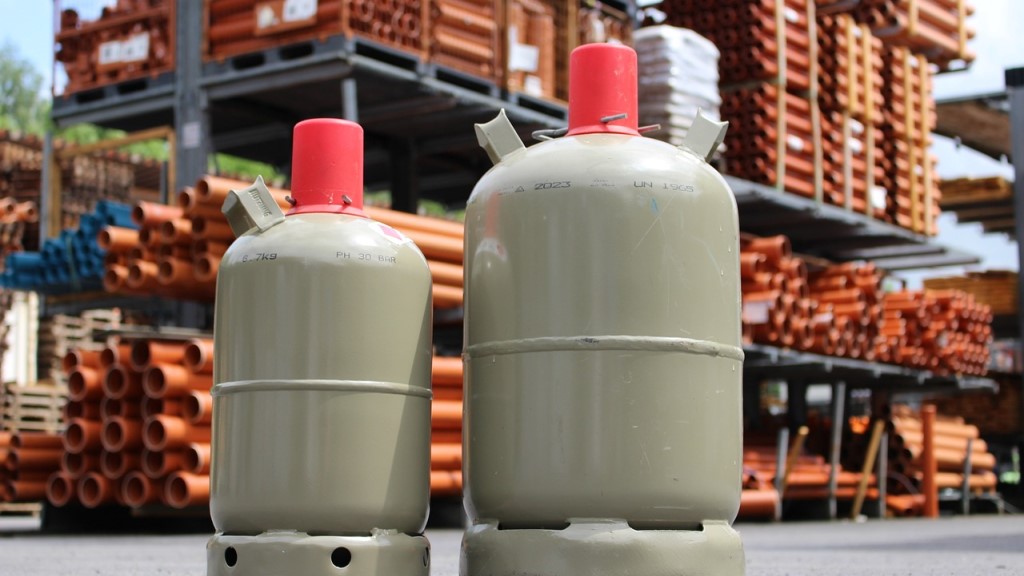
Management of hazardous waste types is handled by both the federal and provincial governments in Canada.
Hazardous waste management in Canada is regulated by both federal and provincial authorities. At the federal level, the Canadian Environmental Protection Act (CEPA) provides the overarching legislative framework for hazardous waste management. It sets out the requirements for the import, export, and transboundary movement of hazardous waste, as well as the control of toxic substances.
Additionally, each province and territory has its own specific regulations that supplement the federal framework. These regulations address issues such as waste classification, labeling, packaging, reporting, and record-keeping requirements. For example, Ontario adheres to the Environmental Protection Act (EPA), The Waste Diversion Act, The Environmental Assessment Act, and the Planning Act to guide both government activity and the actions of private businesses.
It is essential for businesses to be familiar with both federal and provincial regulations to ensure compliance in their respective jurisdictions.
International Agreements Related to Hazardous Waste
At the international level, Canada is a signatory to agreements such as the Basel Convention on the Control of Transboundary Movements of Hazardous Wastes and Their Disposal. This international treaty aims to regulate the transboundary movement of hazardous waste to prevent environmental and health hazards.
Compliance Requirements and Penalties for Non-Compliance
Businesses handling hazardous waste must adhere to specific compliance requirements outlined in the regulations. These requirements typically include proper waste characterization, storage, labeling, transportation, and disposal procedures. Compliance also entails maintaining accurate records, submitting reports, and obtaining necessary permits or licenses.
Non-compliance with hazardous waste regulations can result in significant penalties. These penalties may include fines, legal action, license revocation, and reputational damage. It is crucial for businesses to prioritize compliance and actively engage in hazardous waste management practices that meet or exceed regulatory standards.
Updates and Recent Developments
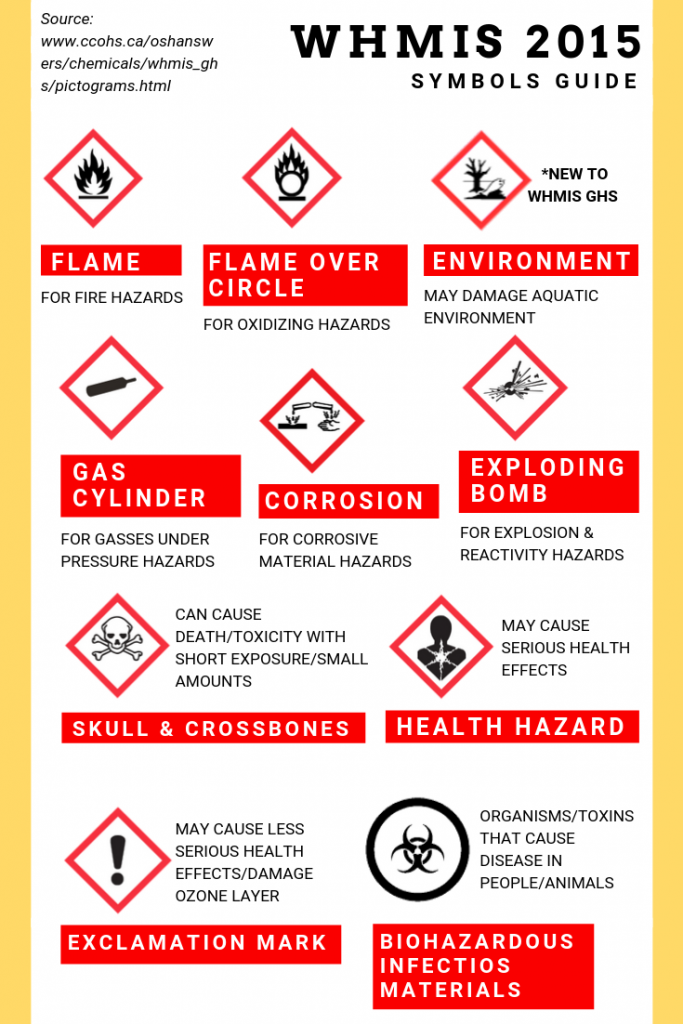
WHMIS was updated in 2015.
Hazardous waste regulations in Canada are dynamic and subject to updates and revisions over time. For example, in 2015, Canada’s Workplace Hazardous Materials Information System (WHMIS) was updated to be more accurate and clearer.
It is essential for businesses to stay informed about any changes and developments in the regulatory landscape. Monitoring updates allows businesses to adapt their practices accordingly and maintain compliance with the latest requirements. This can be done through regular consultations with regulatory agencies, subscribing to industry newsletters, and participating in regular training programs.
By staying abreast of Canadian federal and provincial regulations, key legislation, enforcement agencies, compliance requirements, and other updates, businesses can ensure that their hazardous waste management practices align with the regulatory framework.
4. Employer’s Responsibilities Surrounding Hazardous Waste
Employers have a vital role to play in managing hazardous waste responsibly and safeguarding the well-being of their employees. Understanding and fulfilling their legal obligations is crucial for creating a safe work environment.
Let’s explore the key responsibilities that employers have when it comes to hazardous waste management.
Overview of Legal Obligations
Employers are legally obligated to comply with federal, provincial, and local regulations that govern hazardous waste management. These regulations outline specific requirements for waste handling, storage, transportation, and disposal.
Employers must familiarize themselves with these regulations and ensure that their operations align with the prescribed standards. Failure to comply can result in significant penalties and legal consequences.
Providing Adequate Training and Resources for Employees
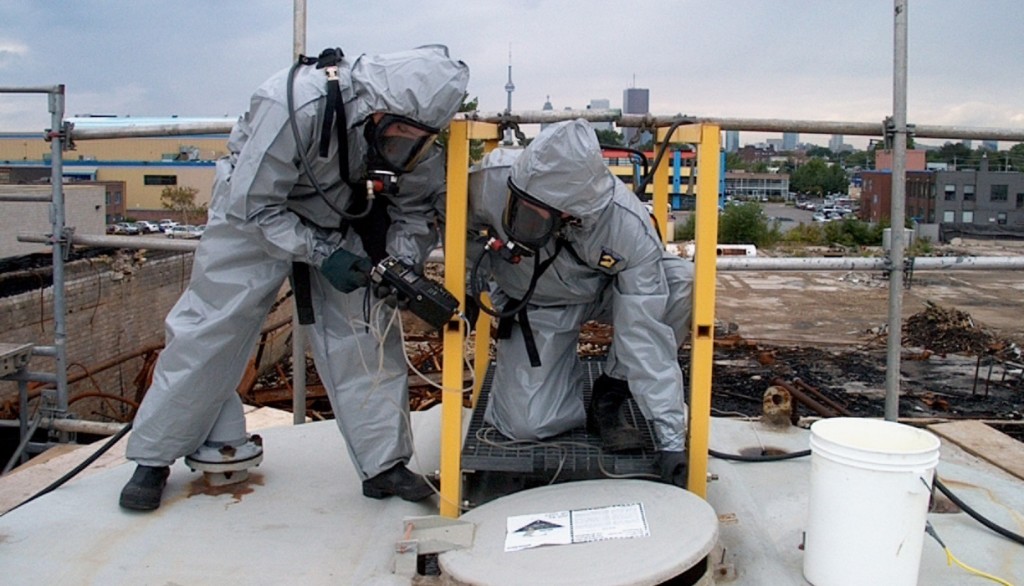
Employers need to provide training about hazardous waste types and how to handle them for their employees.
One of the primary responsibilities of employers is to provide comprehensive training to employees who handle hazardous waste or work in proximity to it. This training should cover key topics such as:
- waste identification
- handling procedures,
- personal protective equipment (PPE) usage
- emergency response protocols
- proper disposal methods
By equipping employees with the necessary knowledge and skills, employers empower them to carry out their tasks safely and effectively.
Employers must also provide the resources and equipment needed to manage all hazardous waste types properly. This includes appropriate storage containers, labeling materials, spill kits, ventilation systems, and any other tools necessary to handle hazardous waste in a safe manner.
Developing and Implementing Safety Protocols and Emergency Response Plans
Employers have a responsibility to establish and enforce robust safety protocols and procedures for hazardous waste management. This involves developing written guidelines for waste handling, storage, transportation, and disposal, as well as establishing clear roles and responsibilities for employees involved in these activities.
In addition, employers must create comprehensive emergency response plans specific to hazardous waste incidents. These plans should outline the necessary steps to be taken in case of spills, leaks, or accidents, and provide guidance on evacuations, medical assistance, and communication with relevant authorities.
Regular drills and exercises should be conducted to ensure employees are familiar with the emergency procedures and can respond effectively in critical situations.
Ensuring Compliance with Regulations and Maintaining Proper Documentation

Employers need to maintain accurate and up-to-date records .
Employers must actively monitor and ensure compliance with hazardous waste regulations. This includes keeping up to date with regulatory changes, conducting regular audits and inspections, and maintaining accurate records of waste generation, storage, transportation, and disposal activities.
Documentation should include the following:
- waste manifests
- permits
- training records
- any other required paperwork
Proper documentation not only demonstrates compliance but also assists in tracking waste streams and identifying areas for improvement.
By fulfilling their responsibilities, employers contribute to a safer work environment, minimize risks to employees, protect the environment, and maintain compliance with legal requirements.
For a complete list of employer responsibilities regarding hazardous wastes, click here.
5. Worker’s Responsibilities Surrounding Hazardous Waste
As stated in the previous section, employers are responsible for making sure that their employees have the proper training when it comes to all hazardous waste types they are exposed to. Here are some of the guidelines that employees need to follow:
Safe Operating Procedures Training
Before you handle hazardous wastes, make sure that you have received instruction, education, and training in the identification system, hazards, safe handling, and storage. You’ll find this information in the Safe Operating Procedures (SOP) for the particular waste that is being handled. Talk to your supervisor if you haven’t received this type of training.
Make sure that you read a copy of the SOP so that you will be sure about the procedures you need to follow before handling hazardous wastes.
Personal Protective Equipment

If you are told to use PPE, then you must do so.
You must wear the proper personal protective equipment (PPE), if you are told to use it. You also need to get training on how to use your PPE properly.
Containers
You should only use containers that are outlined in the SOP for the hazardous waste that you are dealing with. Make sure that the hazardous waste type is compatible with the container that you are going to be using especially if it is a new container. You may also have to label the container following WHMIS or Transportation of Dangerous Goods (TDG) requirements.
You should always seal these containers unless you are actively using them and store them according to the instructions written in the SOP.
In addition, containers with hazardous waste can only be opened in an area designated in the SOP. Never add hazardous waste to a container if you don’t know what it contains or if it isn’t labelled. If you discover a container that isn’t labelled or has unknow contents, report it to your supervisor immediately.
Disposal
The following types of hazardous wastes should never be poured down a sink, floor drain, or into a solid refuse container:
- Solutions with a pH less than 6.0 or greater than 11.5
- Solutions consisting of two or more separate liquid layers
- Liquid with a temperature greater than 60 degrees Celsius
- Acute hazardous waste chemicals
- Flammable or combustible liquids (i.e., those having a flash point under 93.3 Celsius)
- Biomedical waste
- Fuels
- Ignitable wastes
- Hazardous waste chemicals
- Pathological waste
- Pesticides
- Reactive waste
- Severely toxic waste
- Waste radioactive substances
Source: Canadian Centre for Occupational Health and Safety – Hazardous Waste Management
For a complete list of Employee responsibilities regarding hazardous waste, click here.
6. Storage Requirements for Hazardous Waste
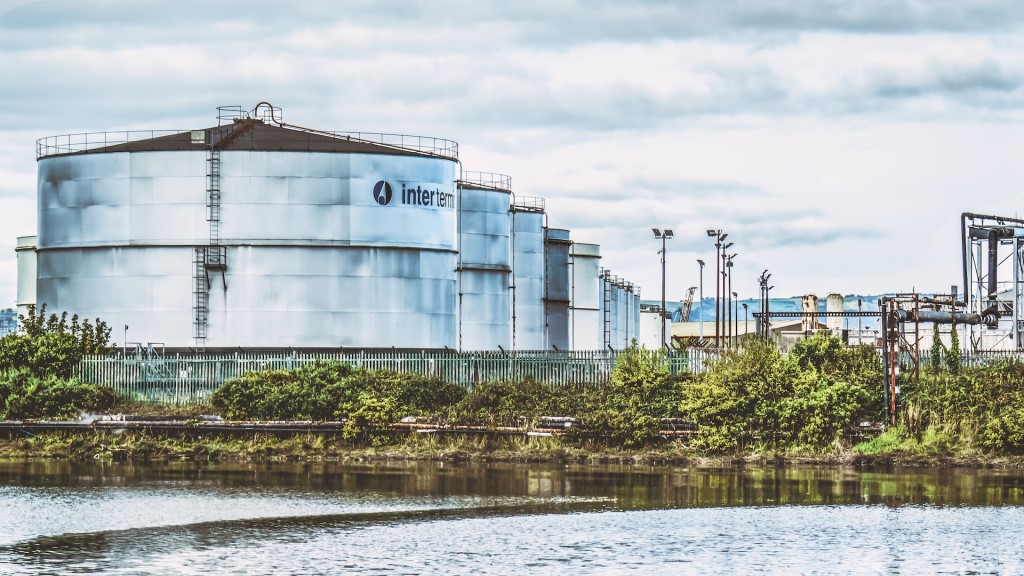
Know the regulations for storage containers in your area. – Photo by K. Mitch Hodge on Unsplash
Hazardous waste storage needs to meet the requirements of your jurisdiction for the following:
- Fire codes
- Industry safe practices like those of the National Fire Protection Agency (NFPA)
- Health and safety legislation
- Environmental legislation
Make sure that you are aware of the specific regulations for the type of hazardous waste that you handle at your facility.
Specific Storage Requirements
To learn about some specific storage requirement for the following types of hazardous waste, consult these resources:
Explosives – Natural Resources Canada R.S.C., 1985, c. E-17, Explosives Act and regulations
Radioactive – Canadian Nuclear Safety Commission CNSC SOR/2000-209, Nuclear Safety and Control Act (S.C. 1997, c.9)
General Storage Requirements
The following are some general storage requirements for hazardous wastes. For a more in-depth list, click here.
Standardized:
The type of storage container you use should be manufactured to a standard such as the United Nations Standardized Containers. They should also be in good condition and not have any leaks.
Compatible:
The containers need to be compatible with the type of materials you are storing in them.
Closed:
Your containers need to be kept closed at all time unless you are adding or removing substances to them.
Secondary Containment:
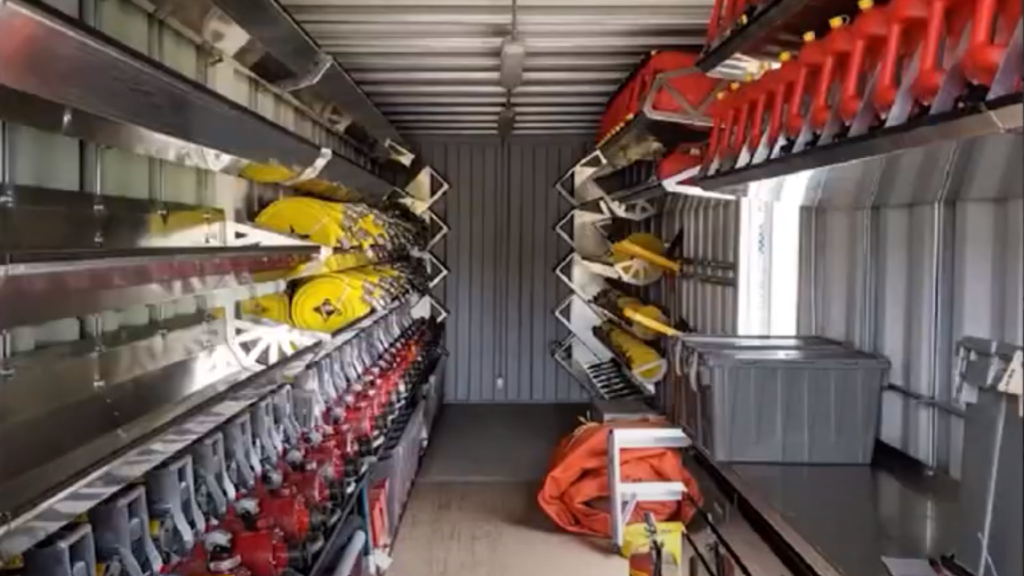
You need to store liquid hazardous waste in a secondary containment. – Image source: The Container Guy
If you are storing liquid hazardous wastes, then you must also have a secondary containment system such as an over-pack drum that contains absorbent materials or an “impervious concrete pad with continuous curbing for tank farms.”
Protected from Precipitation:
The structure where you store your hazardous materials needs to be designed so that precipitation (rain and snow) and surface run-off water is prevented from entering your secondary containment system.
Clearly Labelled:
You need to clearly label each container and tank so that you can easily identify the material being stored. These labels need to be visible and accessible during inspections.
Inspected Weekly:
Your containers need to be inspected each week to check for signs of deterioration or damage from factors such as corrosion. Inspection observations and actions need to be recorded in a logbook. If you find a deteriorated container, you will need to transfer the material to a safe one.
Separate Incompatible Materials:
If you are storing incompatible materials, you need to segregate them withing your storage system, so they don’t come in contact with each other.
Secured Facility:
Your facility needs to be secured to prevent unauthorized persons from entering it. It should be enclosed by a fence and kept locked.
7. Hazardous Waste Program Registry

The Hazardous Waste Program Registry provides a means of more efficient compliance monitoring and timely enforcement actions. – Image Source: RPRA website
The government of Ontario has instituted a program that makes sure that hazardous waste is stored, transported, recycled, recovered, and disposed of properly. As part of this program they have set up an online hazardous waste program registry through the Resource Productivity and Recovery Authority. Prior to January 1, 2023, program registration and reporting was done through the Hazardous Waste Information Network and paper manifests.
This registry enables generators, carriers, and receivers of liquid industrial and hazardous waste to do the following:
- Meet reporting requirements
- Manifest
- Pay fees
- Reduce the number of paper reports that need to be completed and filed
One of the great benefits of this online registry is that it provide a means of more efficient compliance monitoring and timely enforcement actions. This will help to ensure that polluters are held accountable for their actions.
As of January 1, 2023, generators, carriers, and receivers are required to have an account in the new registry in order to do the following:
- Be listed on a manifest
- Create, edit, or sign manifests
- Report on-site waste activities
You can only ship, store, process, or dispose of hazardous waste from facilities and waste streams that are set up in the registry.
If you ship waste outside of Ontario, the receiver in the other province or in the United States also need to use the registry.
Disclaimer: Although every effort is made to ensure the accuracy, currency and completeness of the information, ACUTE does not guarantee, warrant, represent or undertake that the information provided is correct, accurate or current. ACUTE is not liable for any loss, claim, or demand arising directly or indirectly from any use or reliance upon the information.
Trust ACUTE for the Best Safety Training
ACUTE offers an incredibly wide range of health and safety courses. For a complete list of our courses, click here.
To ensure the highest level of safety in your workplace, contact the experts at ACUTE. When you take your safety training from ACUTE, you will be training with the best in the business.
ACUTE Offers:
A world-class facility with real-life simulators
Highly trained instructors with over 100 years of combined, on-site experience
Locally-based company that has a well-earned reputation for excellence and an impressive track record for success
Wide range of clients from many sectors including manufacturing, construction, health, academic, and government
Hours of Operation
Monday – Friday: 8:00am-5:00pm
Saturday – Sunday: Closed

What Our Customers Are Saying…
Acute is recognized and respected as a people organization and they have been doing it right for a long time.
Acute has been a staple in supporting my companies over the years and have always delivered quality amd dependable service. Training programs are top shelf and a great facility for practical application. couldn’t recomend them more. keep up the great work folks.
We were referred to ACUTE on behalf of our employer for an n95 mask fitting – the staff here are professional, personable, and informative.
I’d come back here for any safety-related training in a heartbeat.

